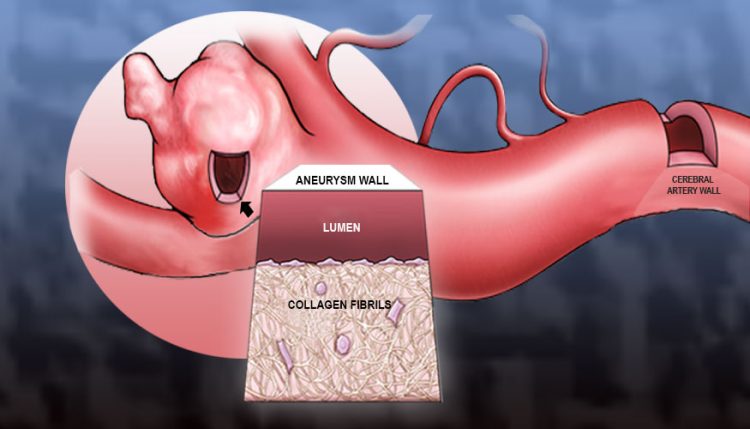A tool to better screen and treat aneurysm patients

A cerebral aneurysm is a blood-filled bulge formed in response to a weakness in the wall at branching brain arteries. If the bulge bursts (shown left), the person can undergo a brain hemorrhage, which is a subtype of stroke and a life-threatening condition. An international team including a researcher from Lawrence Livermore found that the main structural constituent and protein in cerebral aneurysms is distinctly younger than once thought. The new research helps identify patients more likely to suffer from an aneurysm and embark on a path toward prevention.
Using radiocarbon dating to date samples of ruptured and unruptured cerebral aneurysm (CA) tissue, the team, led by neurosurgeon Nima Etminan, found that the main structural constituent and protein — collagen type I — in cerebral aneurysms is distinctly younger than once thought.
The new research helps identify patients more likely to suffer from an aneurysm and embark on a path toward prevention.
Simplified, a CA is a blood-filled bulge formed in response to a weakness in the wall at branching brain arteries. If the bulge bursts, the person can undergo a brain hemorrhage, which is a subtype of stroke and a life-threatening condition.
For decades, doctors have assumed that CAs rarely undergo structural change, and earlier theories speculated that CAs grow at a constant rate. The new findings, which appear in the June print issue of the journal Stroke, challenge the concept that CAs are present for decades and that they undergo only sporadic episodes of structural change. In view of these findings, it seems more likely that they alternate between periods of stability and instability during which they are prone to rupture.
For patients with CAs, who are more likely to undergo an aneurysm rupture due to risk factors such as smoking or hypertension, the international team including LLNL's Bruce Buchholz found that the age of collagen type I was significantly younger than those samples taken from people with no risk factors.
The ample amount of relatively young collagen type I in CAs suggests that collagen is changing all the time in aneurysms, which is significantly more rapid in patients with risk factors, Buchholz said.
Radiocarbon bomb-pulse dating uses an isotopic signature created by above-ground nuclear testing between 1955 and 1963, which nearly doubled the amount of carbon-14 in the atmosphere.
When the above-ground test-ban treaty took effect in 1963, atmospheric levels of radiocarbon began to decline as carbon-14 migrated into the oceans and biosphere. Living organisms naturally incorporate carbon into their tissues as the element moves through the food chain. As a result, the concentration of carbon-14 leaves a permanent time stamp on every biological molecule.
“This research may help doctors to formulate better screening and identification of those people at increased risk of an aneurysm rupture,” Buchholz said.
The prevalence of unruptured CAs in the general population is 2 percent to 3 percent. The rate of death when they rupture is more than 35 percent. The high rate of death has led the medical community to try to understand the formation and natural history of these lesions to define standards for screening, treatment and identification of those CAs that are likely to rupture.
Other institutions include: Department of Neurosurgery and Institute of Forensic Medicine Heinrich-Heine University Institute for Physiological Chemistry and Pathobiochemistry, Westfalian Wilhelms-University; Department of Neurology, Mayo Clinic; Department of Epidemiology, University of Iowa; Division of Neurosurgery, St. Michael's Hospital; Keenan Research Centre for Biomedical Science and the Li Ka Shing Knowledge Institute of St. Michael's Hospital; and the Department of Surgery,University of Toronto.
Media Contact
All latest news from the category: Health and Medicine
This subject area encompasses research and studies in the field of human medicine.
Among the wide-ranging list of topics covered here are anesthesiology, anatomy, surgery, human genetics, hygiene and environmental medicine, internal medicine, neurology, pharmacology, physiology, urology and dental medicine.
Newest articles

Largest magnetic anisotropy of a molecule measured at BESSY II
At the Berlin synchrotron radiation source BESSY II, the largest magnetic anisotropy of a single molecule ever measured experimentally has been determined. The larger this anisotropy is, the better a…

Breaking boundaries: Researchers isolate quantum coherence in classical light systems
LSU quantum researchers uncover hidden quantum behaviors within classical light, which could make quantum technologies robust. Understanding the boundary between classical and quantum physics has long been a central question…

MRI-first strategy for prostate cancer detection proves to be safe
Active monitoring is a sufficiently safe option when prostate MRI findings are negative. There are several strategies for the early detection of prostate cancer. The first step is often a…



